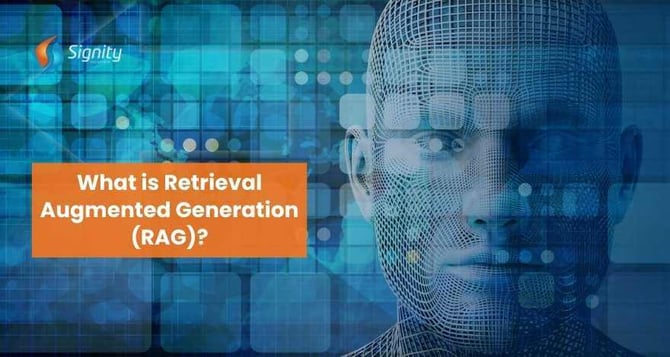What is Retrieval Augmented Generation (RAG)?
Retrieval-Augmented Generation (RAG) enhances the power of AI by combining information retrieval with generative models. This approach grounds AI responses in factual, external data, leading to more accurate, reliable, and contextually relevant content. RAG reduces errors and hallucinations, boosting the overall performance and trustworthiness of AI models.

In the era of artificial intelligence, natural language processing (NLP) has made significant strides. One of the most promising advancements is the Retrieval-Augmented Generation, aka RAG.
RAG combines the power of information retrieval with the capabilities of generative AI models to produce high-quality, informative, and contextually relevant content.
Who Introduced the Term Retrieval-Augmented Generation?
The term Retrieval-Augmented Generation (RAG) was introduced in a 2020 research paper titled "Retrieval-Augmented Generation for Knowledge-Intensive NLP Tasks," co-authored by Patrick Lewis and his team.
Patrick Lewis, now Director of Machine Learning at Cohere, has continued to advance RAG's applications, focusing on improving AI's ability to reference external sources and provide verifiable information.
Must read: Understanding RAG: Architecture, Techniques, Use Cases, & Development, to get a comprehensive understanding of RAG's foundational concepts
Introduction to RAG in Layman Terms: What is It?
RAG is a technique that leverages information retrieval systems to retrieve relevant information from a vast corpus of text and then uses this retrieved information to generate new content.
This approach ensures that the generated content is grounded in factual information, making it more accurate and reliable.
Implementing retrieval augmented generation services allows organizations to easily integrate this capability into their existing AI systems, enhancing performance without the need for complex infrastructure.
How Does Retrieval-Augmented Generation Work?
--> Understanding the Process
Retrieval-augmented generation (RAG) enhances the capabilities of Large Language Models (LLMs) by incorporating external information into the response generation process.
While traditional LLMs rely solely on their pre-trained knowledge, RAG introduces an information retrieval component that fetches relevant data from external sources, enriching the LLM's responses.
--> Key Steps in Retrieval-Augmented Generation (RAG)
1. Create External Data
- Data Sources: External data can come from various sources, including APIs, databases, document repositories, and unstructured text.
- Embedding: To make the data accessible to LLMs, it's often converted into numerical representations using embedding techniques. This creates a knowledge base that the LLM can understand.
- Vector Database: The embedded data is stored in a vector database, which facilitates efficient search and retrieval based on semantic similarity.
2. Retrieve Relevant Information
- Query Embedding: The user query is also converted into a vector representation.
- Similarity Search: The query vector is compared with the vectors in the knowledge base to find the most relevant documents.
- Contextual Understanding: The retrieved documents provide context and specific information related to the user's query.
3. Augment the LLM Prompt
- Contextual Enrichment: The retrieved information is incorporated into the LLM prompt, providing additional context and knowledge.
- Prompt Engineering: Effective prompt engineering techniques guide the LLM in generating a response that is both informative and relevant.
4. Generate Response
- Enhanced Output: The LLM, equipped with the augmented prompt, generates a response that incorporates the retrieved information and leverages its pre-trained knowledge.
Must Read: Our Comprehensive Guide Explaining the RAG Pipeline
The attached image represents the flow of using Retrieval-Augmented Generation with LLMs.
Source: AWS Amazon
--> RAG Challenges and Considerations
- Data Quality: The quality of the external data significantly impacts the accuracy and relevance of the generated responses.
- Data Freshness: Ensuring that the external data is up-to-date is crucial for providing timely and accurate information.
- Computational Cost: Retrieving and processing large amounts of data can be computationally expensive.
- Model Bias: The LLM's underlying biases can influence the generated responses, even when external information is incorporated.
--> Continuous Improvement
To maintain the effectiveness of RAG, it's essential to:
- Regularly Update External Data: As new information becomes available, update the knowledge base to ensure that the LLM has access to the latest data.
- Evaluate Model Performance: Monitor the quality of the generated responses and adjust the RAG system as needed.
- Explore Advanced Techniques: To enhance RAG's performance further, explore techniques like hybrid retrieval models and advanced prompt engineering.
By addressing these challenges and continuously improving the RAG system, organizations can leverage their power to create more informative, accurate, and relevant responses to user queries.
What are the Benefits of Retrieval-Augmented Generation?
- Cost-Effective: RAG allows organizations to use existing foundation models without expensive retraining, making it a more accessible option for implementing generative AI.
- Access to Current Information: RAG can incorporate the latest data from external sources, ensuring that LLMs have access to up-to-date information and can provide relevant and accurate responses.
- Enhanced User Trust: RAG can provide source attribution, increasing transparency and building user confidence in the LLM's responses. This can be particularly important in applications where accuracy and reliability are crucial.
- Greater Developer Control: RAG empowers developers to customize the LLM's behavior by selecting and managing external information sources. This flexibility allows for better alignment with specific use cases and domain requirements.
- Improved Response Quality: By incorporating relevant information from external sources, RAG can help LLMs generate more comprehensive, informative, and contextually relevant responses. This can lead to a better overall user experience.
- Reduced Hallucinations: RAG can help mitigate the risk of LLMs generating incorrect or nonsensical information, known as hallucinations. By grounding responses in factual information, RAG can improve the accuracy and reliability of the generated content.
Integrating external data retrieval with generative models improves the accuracy of AI-generated content. This approach is particularly advantageous in sectors like healthcare, where RAG can provide current medical information, and in customer service, where it allows chatbots to deliver accurate, context-sensitive responses.
To gain a better understanding of RAG's practical applications in various industries, check out 10 Real-World Examples of Retrieval Augmented Generation.
Retrieval-Augmented Generation (RAG) vs. Semantic Search
Understanding the Differences
While both Retrieval-Augmented Generation (RAG) and semantic search involve retrieving relevant information, they serve distinct purposes and operate on different principles.
RAG: A Foundation for Enhanced Generative AI
RAG is a technique that combines information retrieval with generative models to produce high-quality, informative, and contextually relevant content. It's a foundational approach for organizations seeking to improve the capabilities of their Large Language Models (LLMs).
Semantic Search: Elevating RAG Performance
Semantic search, on the other hand, is a specialized technique designed to enhance the retrieval of relevant information from large-scale knowledge bases. It goes beyond keyword-based search to understand the underlying meaning and context of queries, leading to more accurate and informative results.
Key Differences:
- Purpose: RAG aims to improve the overall performance of generative AI models, while semantic search is specifically focused on enhancing information retrieval.
- Scope: RAG operates at a broader level, integrating information retrieval with generative models. Semantic search is more narrowly focused on retrieving relevant information from large-scale knowledge bases.
- Complexity: Semantic search often involves complex techniques like natural language processing and machine learning to understand the meaning of queries and retrieve relevant information. RAG, while still requiring careful implementation, may be less complex in comparison.
The Synergy Between RAG and Semantic Search -
While RAG provides a framework for incorporating external information into generative AI, semantic search can significantly improve the quality of the retrieved information.
By leveraging semantic search techniques, organizations can:
- Enhance RAG results: Retrieve more relevant and accurate information, leading to better-quality generated content.
- Handle large-scale knowledge bases: Efficiently search and retrieve information from vast repositories of documents.
- Reduce developer burden: Automate the process of knowledge base preparation, saving time and effort for developers.
- Improve context understanding: Provide LLMs with more relevant and contextually appropriate information, leading to more informative and accurate responses.
RAG and semantic search are complementary technologies that can work together to enhance the capabilities of generative AI. By combining the power of information retrieval with the ability to understand the underlying meaning of queries, organizations can create more sophisticated and valuable AI applications.
Must Read: RAG vs. Traditional Search Engines: A Comparative Analysis
What Google Cloud Products & Services are Related to RAG?
Vertex AI Search -
- All-in-one solution: Vertex AI Search offers a comprehensive RAG platform that combines information retrieval, embedding generation, and vector search.
- Customizable: Allows you to customize the search index and retrieval process to meet specific requirements.
- Integration with Vertex AI Training: Seamlessly integrates with Vertex AI Training for end-to-end model development and deployment.
Vertex AI Vector Search -
- Scalable: Handles large-scale embedding datasets efficiently, making it ideal for RAG applications.
- Efficient retrieval: Uses advanced indexing and retrieval techniques to find the most relevant information quickly.
- Integration with other products: Can be integrated with Vertex AI Search, BigQuery, and other Google Cloud products.
BigQuery -
- Data storage and analysis: Provides a scalable and cost-effective solution for storing and analyzing large datasets.
- Embedding generation: This can be used to generate embeddings for documents, which can then be used with Vertex AI Vector Search.
- Integration with Vertex AI: Seamlessly integrates with Vertex AI products for a complete AI workflow.
Want to Accelerate Innovation with AI?
Let us help you leverage AI for innovation and stay ahead of the competition. Discover how we can accelerate your growth with AI.
Challenges and Future Directions
While RAG offers significant benefits, there are also challenges to consider:
- Data Quality: The quality of the retrieved information can impact the quality of the generated content.
- Model Bias: Generative models can exhibit biases, which can influence the generated content.
- Computational Cost: RAG can be computationally expensive, especially when dealing with large datasets.
Despite these challenges, the future of RAG is promising. As technology continues to advance, we can expect to see even more innovative applications of RAG in various domains.
Conclusion
Retrieval-augmented generation is a powerful technique that has the potential to revolutionize content creation and information retrieval. By combining the best of both worlds, RAG can generate high-quality, informative, and relevant content that is grounded in factual information.



.png?width=344&height=101&name=Mask%20group%20(5).png)
















